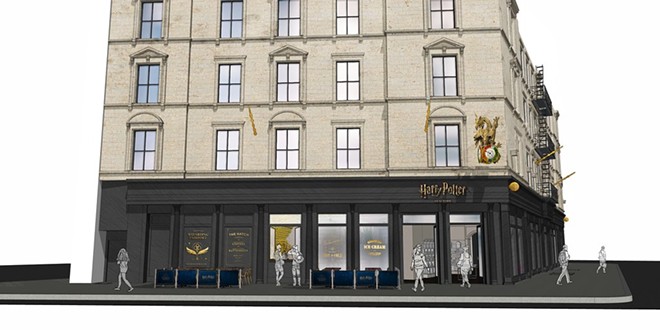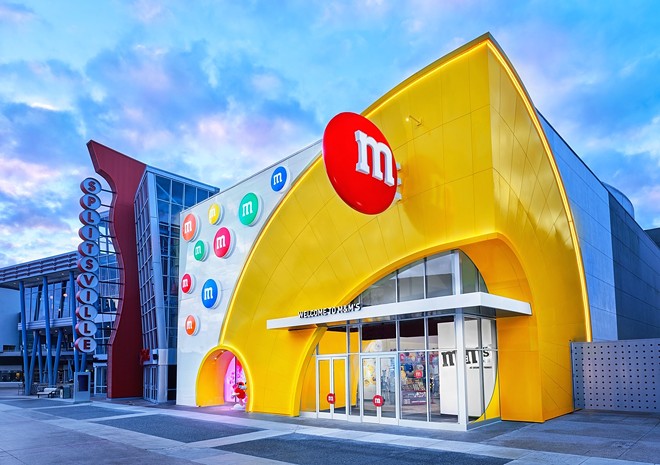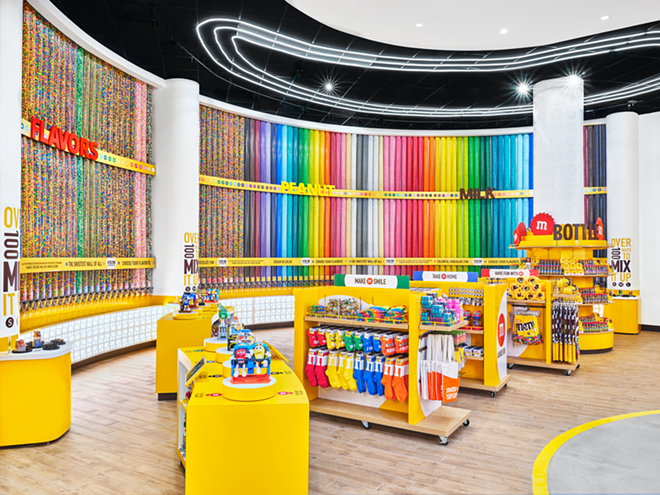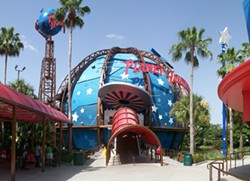Candy brand M&M's debuted a new store at Disney Springs this month, and like so many Disney Springs stores, it's a class in experiential retail. From Instagram-worthy photo-ops to sci-fi technology, the 10,000-square-foot store is as much a celebration of the M&M's brand as it is a place to buy some candy-coated chocolate drops.
M&M's has had a presence in Central Florida for years, with a previous store at the Florida Mall. Like other recent M&M's stores, the Disney Springs one is a bit smaller but remains focused on the experiential aspects that the last store was known for.
Designers Lander & Fitch leave no confusion about what this store is focused on — a colorful ‘Wall of Chocolate’ lines the back of the store, and multiple interactive displays and life-size M&M's figurines are scattered around. Out front, the bright facade could be mistaken for the Instagram walls that have become popular across Disney World.
While some stores at Disney Springs have struggled to stay open, others are frequently so busy they require queues or virtual reservations. This is true at the nearby Coca-Cola store and the flagship World of Disney store. The Coke store has guests traverse multiple levels, each with its own unique take on the brand. Light fixtures made from recycled Coke bottles provide ambience, and in one corner, guests can have their photo taken with Coco-Cola polar bear. After successfully navigating the multi-story ramp that winds around the retail store, guests come to a rooftop bar. While taking in the views of Disney Springs, guests can enjoy Coke flights and custom cocktails.
With its faux natural elements and faux street scene retail corridors, hosting a lineup of mega brands, Disney Springs is the ideal representation of American retail in this third decade of the 21st century. At the core of this is the successful realization of experiential retail.
Disney Springs, and its predecessor Downtown Disney, have always been at the forefront of this trend. In the 1990s, when brands like Warner Brothers and Rainforest Café filled shopping malls with animatronics, interactive screens, and larger-than-life themed elements, Downtown Disney was right there building a fire-breathing volcano to top its Rainforest Café and a new Planet Hollywood restaurant inside a giant globe where guests entered under a life-size UFO.
Even when the shopping complex was still known as the Lake Buena Vista Shopping Village, it was more than just a shopping plaza. From the beginning, when it was designed as the commercial corridor for a never-built city, the retail was augmented with playgrounds and picture-perfect landscaping. As shopping centers evolved into the go-to third place for Americans, Disney’s continued to remain ahead of the curve by adding a nightclub district, a massive movie theater complex, and eventually a secondary avenue capped by a gigantic arcade and Vegas-style theatre.
Then in the middle of the last decade, as retailers across the nation began to suffer, Disney once again showed where the industry was headed when they ripped up their surface parking lots to replace them with a faux town center filled with a mix of major brands and bespoke local flair. The move has proven that a local bakery can demand the same hours-long waits once reserved for the likes of Apple stores and Black Friday sales.
Malls tried to supplement the decline in retail foot traffic with family entertainment centers that were not that different from the indoor theme park arcade that once greeted guests at Disney Springs. But just as Disney realized, these malls are now seeing that bumper cars, VR, and arcade games can only get you so far. The pandemic has highlighted this fact just as it has sped up the trend of at-home shopping. Luckily, Disney has already shifted away from the family entertainment center as the anchor model. The very footprint of where the DisneyQuest arcade once sat is now a small NBA attraction with its own experiential retail gift shop.
From Krispy Kreme to Major League Baseball, brands are going all-in on flagship stores filled with opportunities for consumers to connect to the brand in new ways. Krispy Kreme’s flagship store will have a ‘donut theater’ where guests can sit in stadium-style seating to watch donuts being made. Lighting that simulates the California sunset can be found in UGG’s new flagship store, where guests can charge their smart devices at a custom-designed bench that doubles as the stores’ window display shelf. These stores are designed to bring the brand to consumers via unique experiences that resonate with them far beyond what items on a shelf could.

Few understand the power of experiences better than Dave Cobb. The California-based designer was the creative director behind Universal Orlando’s Men in Black ride. More recently, he served as the creative lead for Warner Bros. World Abu Dhabi, the award-winning indoor theme park that is now viewed as the golden standard for indoor-themed attractions. Cobb explains that as we shift into the post-pandemic ‘new normal’ we’ll see more themed experiences, including in retail partly thanks to the pandemic itself.
“For the past year, most of us have been shopping online, and only occasionally, briefly and cautiously in-person at brick-and-mortar stores when absolutely necessary; add to that the staggering unemployment rates that make discretionary spending beyond luxury for most people. While I don’t think we’re going to be back to ‘normal’ quickly, there will obviously be a demand for more out-of-home, social experiences, and that includes shopping for pleasure.”
One group to thank for the re-emergence in experiential retail is theme parks. The past decade has seen Universal Studios become a leader in experiential retail. After their introduction in 2010, the wand experience and butterbeer redefined what a Universal Orlando vacation includes. Within seven months of opening the Wizarding World, Universal had already sold over 1 million butterbeers.
Disney quickly followed suit by introducing its own unique retail and beverage offerings at the Magic Kingdom’s New Fantasyland. It then tried to replicate it again at Pandora: The World of Avatar and Star Wars: Galaxy’s Edge. The lightsaber experience at Galaxy’s Edge takes the idea of purchasing a gift and fuses it with an almost spiritual ceremony. It’s not uncommon to see guests fighting back tears during the finale of the ceremony.
At Disney, experiential retail isn’t reserved to just the theme parks. Recently Imagineers reimagined the former Rainforest Café at the Disneyland Resort as a Star Wars-themed shopping experience. The jungle outpost kept many of the themed elements of the former tenant but intermingled with them are iconic items from the Star Wars universe.
“Theme parks have long made retail a full experience — be it the magic of having your wand choose you at Ollivanders, or the ritual/spectacle of building your own lightsaber or droid — and that trend will certainly expand and continue outside of admission-based spaces like theme parks,” Cobb explains.
Even while the company is seemingly going in a different direction with its own retail, with the help of brands like Coke and M&M's, Disney has shown that experiential retail does resonate with today’s demanding consumers. At the more than a dozen other retail major centers spread across Central Florida, it’s still too early to know if they — and Disney — are ready to listen.
The M&M's store in Disney Springs West Side is now open daily. For those wanting to experience the store from home, a fully interactive virtual store experience can be found on the Disney Springs M&M's Store website.
M&M's has had a presence in Central Florida for years, with a previous store at the Florida Mall. Like other recent M&M's stores, the Disney Springs one is a bit smaller but remains focused on the experiential aspects that the last store was known for.
Designers Lander & Fitch leave no confusion about what this store is focused on — a colorful ‘Wall of Chocolate’ lines the back of the store, and multiple interactive displays and life-size M&M's figurines are scattered around. Out front, the bright facade could be mistaken for the Instagram walls that have become popular across Disney World.
While some stores at Disney Springs have struggled to stay open, others are frequently so busy they require queues or virtual reservations. This is true at the nearby Coca-Cola store and the flagship World of Disney store. The Coke store has guests traverse multiple levels, each with its own unique take on the brand. Light fixtures made from recycled Coke bottles provide ambience, and in one corner, guests can have their photo taken with Coco-Cola polar bear. After successfully navigating the multi-story ramp that winds around the retail store, guests come to a rooftop bar. While taking in the views of Disney Springs, guests can enjoy Coke flights and custom cocktails.
With its faux natural elements and faux street scene retail corridors, hosting a lineup of mega brands, Disney Springs is the ideal representation of American retail in this third decade of the 21st century. At the core of this is the successful realization of experiential retail.
Disney Springs, and its predecessor Downtown Disney, have always been at the forefront of this trend. In the 1990s, when brands like Warner Brothers and Rainforest Café filled shopping malls with animatronics, interactive screens, and larger-than-life themed elements, Downtown Disney was right there building a fire-breathing volcano to top its Rainforest Café and a new Planet Hollywood restaurant inside a giant globe where guests entered under a life-size UFO.
Even when the shopping complex was still known as the Lake Buena Vista Shopping Village, it was more than just a shopping plaza. From the beginning, when it was designed as the commercial corridor for a never-built city, the retail was augmented with playgrounds and picture-perfect landscaping. As shopping centers evolved into the go-to third place for Americans, Disney’s continued to remain ahead of the curve by adding a nightclub district, a massive movie theater complex, and eventually a secondary avenue capped by a gigantic arcade and Vegas-style theatre.
Then in the middle of the last decade, as retailers across the nation began to suffer, Disney once again showed where the industry was headed when they ripped up their surface parking lots to replace them with a faux town center filled with a mix of major brands and bespoke local flair. The move has proven that a local bakery can demand the same hours-long waits once reserved for the likes of Apple stores and Black Friday sales.
Malls tried to supplement the decline in retail foot traffic with family entertainment centers that were not that different from the indoor theme park arcade that once greeted guests at Disney Springs. But just as Disney realized, these malls are now seeing that bumper cars, VR, and arcade games can only get you so far. The pandemic has highlighted this fact just as it has sped up the trend of at-home shopping. Luckily, Disney has already shifted away from the family entertainment center as the anchor model. The very footprint of where the DisneyQuest arcade once sat is now a small NBA attraction with its own experiential retail gift shop.
As retailers look to rebuild after the pandemic, the Field of Dreams model that worked for malls in the late 20th century no longer stands. Neither does the beer-and-bowling model that kept many retail centers active after the Great Recession. Consumers are now looking at authentic connections with brands in immersive physical settings that they can’t experience at home or their local family entertainment center.
Unlike in the 1980s and '90s, when the trend was first born, this latest revival has one distinct difference. Back then, the retail stores were quickly replicated and soon filled malls in every market. This time each store is unique, with only a handful in operation, making them magnets for fans. That difference also means large brands won’t be enough to save many retail centers; instead, they’ll only be found in high-traffic destinations like Disney Springs. The Orlando M&M's store is just one of five in the world. Coca-Cola has just two other retail stores outside of the Orlando one.
Even Disney seems to be shifting to this model of fewer but more flagship-style stores, with the handful of World of Disney stores staying open as rumors point to many of the Disney Stores found in malls not reopening post-pandemic. Disney has already closed 17 Disney Stores nationwide. Instead, the company is opting for a partnership with Target and a focus on online retail. The remaining World of Disney stores are massive shopping experiences, with multiple rooms of retail and design elements that Disney says will make you “want to snap off a selfie to commemorate this ultimate Disney shopping experience.”
Disney’s leading role in the experiential retail renaissance is a bit ironic considering their misses lately, such as the push for a more generic design aesthetic in the World of Disney stores and hotel rooms across the company’s portfolio. As more places embrace in-store cafes and experiences, Disney removed their in-shop kid-focused beauty salons and ripped out many of the iconic props that the World of Disney stores were once known for. Still, in these stores that some have criticized for their “bland modern look,” themed elements do remain, albeit far fewer than were previously there.
As more shopping shifts online, retail stores will become brand experiences that are as much a connection with the brand as they are a place to purchase items. Warner Bros., which had its own successful line of retail stores in the 1990s, is now looking to get back into the game with a massive Harry Potter-themed retail store in New York City. In the vein of the flagship stores that once filled Times Square, the new Harry Potter store is designed to be an attraction in and of itself. Unlike in the 1980s and '90s, when the trend was first born, this latest revival has one distinct difference. Back then, the retail stores were quickly replicated and soon filled malls in every market. This time each store is unique, with only a handful in operation, making them magnets for fans. That difference also means large brands won’t be enough to save many retail centers; instead, they’ll only be found in high-traffic destinations like Disney Springs. The Orlando M&M's store is just one of five in the world. Coca-Cola has just two other retail stores outside of the Orlando one.
Even Disney seems to be shifting to this model of fewer but more flagship-style stores, with the handful of World of Disney stores staying open as rumors point to many of the Disney Stores found in malls not reopening post-pandemic. Disney has already closed 17 Disney Stores nationwide. Instead, the company is opting for a partnership with Target and a focus on online retail. The remaining World of Disney stores are massive shopping experiences, with multiple rooms of retail and design elements that Disney says will make you “want to snap off a selfie to commemorate this ultimate Disney shopping experience.”
Disney’s leading role in the experiential retail renaissance is a bit ironic considering their misses lately, such as the push for a more generic design aesthetic in the World of Disney stores and hotel rooms across the company’s portfolio. As more places embrace in-store cafes and experiences, Disney removed their in-shop kid-focused beauty salons and ripped out many of the iconic props that the World of Disney stores were once known for. Still, in these stores that some have criticized for their “bland modern look,” themed elements do remain, albeit far fewer than were previously there.
From Krispy Kreme to Major League Baseball, brands are going all-in on flagship stores filled with opportunities for consumers to connect to the brand in new ways. Krispy Kreme’s flagship store will have a ‘donut theater’ where guests can sit in stadium-style seating to watch donuts being made. Lighting that simulates the California sunset can be found in UGG’s new flagship store, where guests can charge their smart devices at a custom-designed bench that doubles as the stores’ window display shelf. These stores are designed to bring the brand to consumers via unique experiences that resonate with them far beyond what items on a shelf could.

Image via Harry Potter New York
Concept art for the Harry Potter flagship store opening in 2021 at 935 Broadway in New York.
Few understand the power of experiences better than Dave Cobb. The California-based designer was the creative director behind Universal Orlando’s Men in Black ride. More recently, he served as the creative lead for Warner Bros. World Abu Dhabi, the award-winning indoor theme park that is now viewed as the golden standard for indoor-themed attractions. Cobb explains that as we shift into the post-pandemic ‘new normal’ we’ll see more themed experiences, including in retail partly thanks to the pandemic itself.
“For the past year, most of us have been shopping online, and only occasionally, briefly and cautiously in-person at brick-and-mortar stores when absolutely necessary; add to that the staggering unemployment rates that make discretionary spending beyond luxury for most people. While I don’t think we’re going to be back to ‘normal’ quickly, there will obviously be a demand for more out-of-home, social experiences, and that includes shopping for pleasure.”
One group to thank for the re-emergence in experiential retail is theme parks. The past decade has seen Universal Studios become a leader in experiential retail. After their introduction in 2010, the wand experience and butterbeer redefined what a Universal Orlando vacation includes. Within seven months of opening the Wizarding World, Universal had already sold over 1 million butterbeers.
Disney quickly followed suit by introducing its own unique retail and beverage offerings at the Magic Kingdom’s New Fantasyland. It then tried to replicate it again at Pandora: The World of Avatar and Star Wars: Galaxy’s Edge. The lightsaber experience at Galaxy’s Edge takes the idea of purchasing a gift and fuses it with an almost spiritual ceremony. It’s not uncommon to see guests fighting back tears during the finale of the ceremony.
At Disney, experiential retail isn’t reserved to just the theme parks. Recently Imagineers reimagined the former Rainforest Café at the Disneyland Resort as a Star Wars-themed shopping experience. The jungle outpost kept many of the themed elements of the former tenant but intermingled with them are iconic items from the Star Wars universe.
“Theme parks have long made retail a full experience — be it the magic of having your wand choose you at Ollivanders, or the ritual/spectacle of building your own lightsaber or droid — and that trend will certainly expand and continue outside of admission-based spaces like theme parks,” Cobb explains.
Even while the company is seemingly going in a different direction with its own retail, with the help of brands like Coke and M&M's, Disney has shown that experiential retail does resonate with today’s demanding consumers. At the more than a dozen other retail major centers spread across Central Florida, it’s still too early to know if they — and Disney — are ready to listen.
The M&M's store in Disney Springs West Side is now open daily. For those wanting to experience the store from home, a fully interactive virtual store experience can be found on the Disney Springs M&M's Store website.
–
Stay on top of Central Florida news and views with our weekly newsletters, and consider supporting this free publication. Our small but mighty team is working tirelessly to bring you Central Florida news, and every little bit helps.







